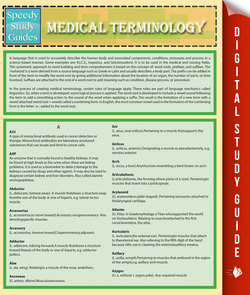Читать книгу Medical Terminology (Speedy Study Guides) - Speedy Publishing - Страница 2
На сайте Литреса книга снята с продажи.
ОглавлениеIs language that is used to accurately describe the human body and associated components, conditions, processes and process in a science-based manner. Some examples are: R.I.C.E., trapezius, and latissimus dorsi. It is to be used in the medical and nursing fields. This systematic approach to word building and term comprehension is based on the concept of: word roots, prefixes, and suffixes. The ‘root word’ is a term derived from a source language such as Greek or Latin and usually describes a body part. The prefix can be added in front of the term to modify the word root by giving additional information about the location of an organ, the number of parts, or time involved. Suffixes are attached to the end of a word root to add meaning such as condition, disease process, or procedure.
In the process of creating medical terminology, certain rules of language apply. These rules are part of language mechanics called linguistics. So, when a term is developed, some logical process is applied. The word root is developed to include a vowel sound following the term to add a smoothing action to the sound of the word when applying a suffix. The result is the formation of a new term with a vowel attached (word root + vowel) called a combining form. In English, the most common vowel used in the formation of the combining form is the letter -o-, added to the word root.
A
A33
A type of monoclonal antibody used in cancer detection or therapy. Monoclonal antibodies are laboratory-produced substances that can locate and bind to cancer cells.
AAP
An enzyme that is normally found in healthy kidneys. It may be found at high levels in the urine when there are kidney problems. It is used as a biomarker to detect damage to the kidneys caused by drugs and other agents. It may also be used to diagnose certain kidney and liver disorders. Also called alanine aminopeptidase.
Abductor
(L. abducere, to move away). A muscle that draws a structure away from the axis of the body or one of its parts, e.g. lateral rectus muscle.
Accessorius
(L. accessorius, to move to ward). Accessory or supernumerary. Also de noting specific muscles.
Accessory
(L. accessorius, to move to ward). Supernumerary, adjuvant.
Adductor
(L. adducere, to bring for ward). A muscle that draws a structure to ward the axis of the body or one of its parts, e.g. adductor pollicis.
Alae
(L. ala, wing). Relating to a muscle of the nose, and others.
Anconeus
(G. ankon, elbow). Musculusanconeus.
Ani
(L. anus, anal oriface). Pertaining to a muscle that supports the anus.
Anticus
(L. anticus, anterior). Designating a muscle as placed anteriorly, e.g. serratus anterior.
Arch
(L. arcus, a bow). Anystructure resembling a bent bowor an arch.
Articulationis
(L. articulationes, the forming of new joints of a vine). Pertaining to muscles that insert into a joint capsule.
Arytenoid
(G. arytenoideus, ladel-shaped). Pertaining to muscle attached to this laryngeal cartilage.
Atlanto-
(G. Atlas, in Greek mythology a Titan who supported the world on his shoulders). Relating to muscles attached to the first cerviclevertebra, the atlas.
Auricularis
(L. auricularis, the external ear). Pertaining to muscles that attach to the external ear. Also referring to the fifth digit of the hand because of its use in cleaning the external auditory meatus.
Axillary
(L. axilla, armpit). Pertaining to muscles that are found in the region of the armpit, e.g. axillary arch muscle.
Azygos
(G. a, without + zygon, yoke). Any unpaired muscle.
